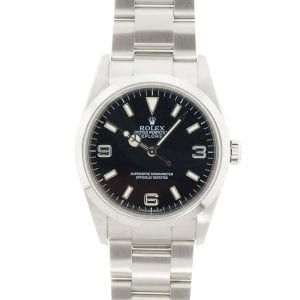Tucked among the lineup of imposing Rolex sports watches like the Submariner, Daytona, GMT-Master, and Yacht-Master, sits a much more understated Rolex sports watch dubbed the Explorer. As some of you may know, the Explorer was launched in 1953 to commemorate Sir Edmund Hillary and Tenzing Norgay’s historic climb to the top of Mount Everest earlier that year.
As the watch’s name suggests, the Explorer Rolex watch was built for those who seek adventure. It was a durable timepiece crafted in stainless steel, had a clean and legible dial that could be read even under the more difficult environments, was water resistant, and of course, offered reliable timekeeping thanks to its automatic movement.
Over the next six decades, while Rolex improved and slightly modified the Explorer, many of the design details that distinguish this particular model remained the same. Let’s compare the last two Explorer references—the Rolex Explorer 114270 vs. the Rolex Explorer 214270—to highlight the differences and similarities.
The Rolex Explorer ref. 114270
 The Rolex introduced the Explorer ref. 114270 in the early 2000s. Like its predecessors, this version of the Explorer sports a 36mm stainless steel Oyster case water resistant to 100 meters (330 feet) and a matching stainless steel Oyster bracelet. It’s worth mentioning that the bracelet of the ref. 114270 has solid end links (SEL) rather than the hollow ones found on older models.
The Rolex introduced the Explorer ref. 114270 in the early 2000s. Like its predecessors, this version of the Explorer sports a 36mm stainless steel Oyster case water resistant to 100 meters (330 feet) and a matching stainless steel Oyster bracelet. It’s worth mentioning that the bracelet of the ref. 114270 has solid end links (SEL) rather than the hollow ones found on older models.
There’s also the familiar black glossy dial with the signature 3, 6, and 9 numerals. For luminescence, the Rolex Explorer ref. 114270 has Superluminova coating on the center Mercedes-style hands, baton hour markers and inverted triangle at 12 o’clock—but not on the trio of Arabic numerals.
Powering the Explorer ref. 114270 is the COSC-certified Caliber 3130 automatic movement with 48 hours of power reserve.
The Rolex Explorer ref. 214270
 In 2010, Rolex replaced the ref. 1142170 with the Explorer ref. 214270 and with the new model, brought about big changes to the watch. First of all, the case size increased to 39mm, making the new ref. 214270 a much larger watch. The heftier build of the Explorer ref. 214270 is further emphasized by its broader case design. The bracelet also comes with the more robust Oysterlock clasp and the practical Easylink 5mm extension system.
In 2010, Rolex replaced the ref. 1142170 with the Explorer ref. 214270 and with the new model, brought about big changes to the watch. First of all, the case size increased to 39mm, making the new ref. 214270 a much larger watch. The heftier build of the Explorer ref. 214270 is further emphasized by its broader case design. The bracelet also comes with the more robust Oysterlock clasp and the practical Easylink 5mm extension system.
Dial-wise, Rolex made some changes including moving the EXPLORER label from the upper portion of the dial to the lower section. Furthermore, the iconic 3/6/9 numerals are now fashioned in 18k white gold.
Beneath the steel caseback of the Explorer ref. 214270 lies the Caliber 3132, also with 48 hours of power reserve, but boasting the Parachrom hairspring and Paraflex shock absorbers for increased durability. In 2016, Rolex made a surprising move by updating the Explorer ref. 214270 with longer and broader hands in addition to luminescent 3, 6, and 9 numerals, but kept the same reference number.
In short, the Explorer ref. 114270 is the smaller and more classic version of the Explorer, while the Explorer ref. 214270 is the larger and more modern iteration. Regardless of which model you opt for, these are fantastic watches that are not only an important part of Rolex’s history, but the Explorer timepieces are also some of the most affordable Rolex sports watches available today.



